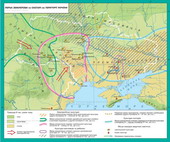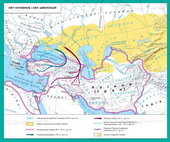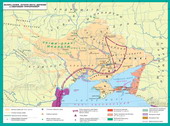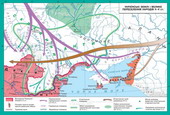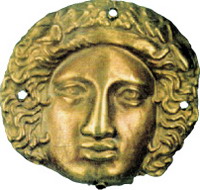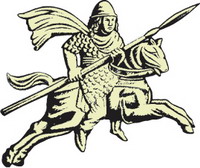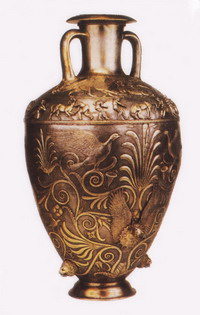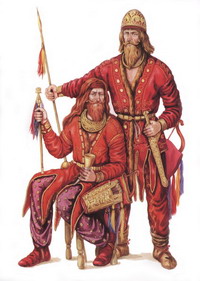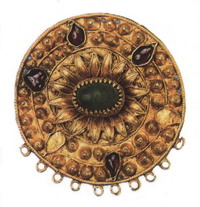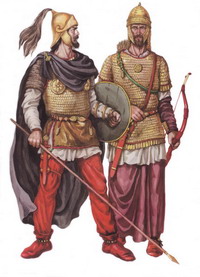§ 5. Masteringprimitive man in Ukraine. The first farmers and herders in theUkraine
1. Zalyudnennyain Ukraine
The territory of Ukraine, and Europe as a whole,be outside the region in which there was Human evolution - Processtransformation of humanoid creatures on a person. The first creature that came toEurope was in a "man with a straight gait (the most developed of the humanoidcreatures), or arhantrop (Pralyudyna) or pyatykantrop. About 1 millionyears ago they appeared in Eastern Europe. The most famous of parking arhantropivfound in Ukraine in 1974 near s.Koroleve TranscarpathiaKiev archaeologist V. Hladilinym.
Arhantropy constantly movedsmall groups in search of food. They ate fruit collected,shoots, roots, and hunted small animals, sometimes - and in large- Elephants, hippopotamus, buffalo and others. Arhantropy learned to usefire. Raise it and they could not use natural, carefullykeeping house. Fire played an important role in human progress, helpedsurvive under severe cooling on Earth. During glacier advancearhantropy survived only in the southern region of our country.
The final link of anthropowere paleoantropy (old people) or Neanderthals. Other limits on theextraction of plant foods has caused what their main occupation was huntingon the great beast. Booty hunters were mammoths, hairy rhinos, vivtsebyky,caribou, bison, bears. Vpolovuvaly major animal group.
The number of men of that time, parking,Archaeologists found in Ukraine, shows a marked increasepopulation. Finding food hunters were forced to move from one place to another.Rich in prey location, and cold winter led people to follow theseplaces longer and build housing. It is based taught with stones and bonesmammoth, inserted between them and the branches covered with skins on top.
Middle 40-35 thousand years agoprevailed in Ukraine "a man of understanding."
The new man was primarily beingpublic - worked and lived in the team, had a language and memory, rationalknowledge and creative thinking, certain rules of morality, creating a marriage and familywas able to artistic creativity.
The first period of human history was likecontinue domination era assigning forms management - hunting,dopovnyuvanoho fishing and gathering. The leading subject of hunting inMiddle Dnieper was mammoth. Village at Mammoth Hunters aroseriver valleys, where the migratory paths of these great animals. Their remainsfound in Chernihiv (Mizyn, Pushkari), Cherkassy (Mezhyrichi), Poltava(The posts) at altitudes Kyrylivsky in Kiev. In the southern strip of the main Ukrainebecame the object of hunting buffalo. Unlike these mammoth animals movedopen spaces, hunters waiting near their natural pitfalls - ravines,fall more. Together they organized their settlements. A striking exampleseasonal settlement hunters of bison is Amvrosiyivske stoybysche in Donbass.In a narrow ravine along a long and left about a thousand skeletonsLegally Harvested bison.
Coincides with the beginning of Mesolithicend of the Ice Age. Amended natural condition foreverforsaken planet mammoths and other large animals of that time. "Doba northdeer in Europe called the beginning of Mesolithic researchers after this animal that wasdominant. Hunters of the day had to learn the customs deerand learn how to organize collective hunting for their herds.
With further warming deer departednorth. The disappearance of large gregarious animals caused crisis Huntingeconomy, which pushed people to new inventions. Its mainachievement at that time was a bow with arrows - one of the first mechanicaldevices invented by man. Bow hunters allowed to hunt not only forlarge animals, but also Prudkih small animals, birds. Loyal friendMesolithic hunters became the dog - the first man domesticated wild animal.In the human diet was replaced by large fish. At this timeinvented-dugout boats, fishing hook, harpoon. Enrichment plantworld led to activation of collecting and nurturing, especially celebrating fields.
In the new environment of human groupswere small mobile communities. With good knowledge of seasonal opportunitiesdifferent natural lines, they seek food, often moved in differentdirections. Active people gradually caused depletion of naturalresources, in particular - the destruction of the beast. It is forced to seek new means ofexistence. This has resulted in changes that took place the next day -Neolithic.

The most ancient past of Ukraine
Interestingknow
Archaeological periodsAncient History of Ukraine *
The first step in history- Stone age - in turn divided into:
PaleolithicOr oldStone Age (about 800-11 thousand years BC);
MesolithicOr averagestone age (10.6 thousand years BC);
NeolithOr newstone age (5.4 thousand yearsBC);
eneolith, or copper-stone age 'Bila (4-3 thousand years BC);
bronzeage (2 thousand years BC - 11 century BC.)
earlyIron Age (11 century BC. - Article 4. BC).
* Common to all countriesperiodization of the world does not exist because the pace of human development in different regionsour planet at the same time do not coincide.
2. The first farmersand pastoralists
The territory of Ukraine as a wholeEurope was not a region of origin and breeding agriculture. Although the first attemptsdomestication of animals (bovine and swine) as evidence archaeological finds wereCommitted to our land in the steppe Dnieper and the Crimea back in the Mesolithic.
The spread of new forms of management onUkrainian lands dates back 5.6 thousand BC There was because itrelocation of the tribes here farmers and herdsmen, and through borrowinglocal people new achievements. The unique environmental conditions in Ukrainecaused the dominance of the two forms of economic - Agricultural and forest-steppesteppe cattle. Routes for Ukrainian agriculture land withFront Asia goes through the Mediterranean islands and the Balkans.
Representatives came to farmingtribes were carriers of culture Linear Band Pottery. Accordingarchaeological finds, they were fairly well-developed economy. These tribeskept big and small cattle, grew some wheat varietiesbarley, millet, peas, etc.. In Europe, this culture spread on agriculturalVolyn Podolia and even to England, Holland and France.
One of the first localagricultural-forest-breeding of cultures has Bug-Dniester. Itsmedia did only the first steps in the development of new forms of economy, whichcoexisted with hunting and fishing. Spring Bug-dnistrovtsi movedon the banks of the rivers where floodplains, just in raw sludge, grain sown. Nearbybuilt housing and grazed cattle. In autumn, gathering fruit, left to floodplain andreturned to nearby dense forest.
Start spreading in cattlesteppe zone associated with Surs'ko-Dnieper culture. Its attractionsfound mostly in Nadporizhzhi Dnieper. New forms of mediathis culture combined with traditional ways of obtaining food, in particularfishing. In summer these tribes rozselyalysya on the banks of rivers rich in fish.Along the meadows vypasalasya cattle. On the ground, settlements are found bones domesticanimals - a bull and pig. Cattle breeding, as evidenced by archaeological finds,was given more attention than agriculture.
Thus, in the Neolithic AgeUkraine, like other regions of Europe, was the start time distribution of agricultureand cattle. This was a revolutionary step in history of ancient societiesour country.

The first farmers and herders onin Ukraine
Interestingknow
10 thousand BCThe beginning of agriculture in Front Asia.
7 - 6 thousand years toBC In Ukraine, the first domesticated animals - pig and bull.
second half of the 5 thousandBC The spread of culture Linear Band Pottery - oldest farmersNeolithic middle zone of Europe.
end June - early5 thousand BC The emergence of Eastern Europe pottery.
end June - early5 thousand BC Bug-Dnieper culture, ancient farmers inUkraine.
5 - Top 4 thousand toBC Surs'ko-Dnieper culture.
end of the 5 - 4 thousand toBC Domesticated sheep and goats.
3. Farmers andperiods of Bronze Age cattle. Tripillian culture.
During periods of Bronze Age on the territory of Ukraineestablished two economic systems - agricultural and pastoral. These two differentworlds different kind of rhythm of life, mentality, a kind ofmaterial and spiritual culture.
In the late nineteenth century. archaeologistVikenty Chvojka around the city of Tripoli in Kiev region found the remains of ancienthuman settlements. Found our culture has named Trypillian. It was common in the forest steppe zone and heldIn the heyday of about 200 km2. It waslargest agricultural Bronze Age culture, the media is moved to our landfrom the Mediterranean.

Trypillian women in sleeveless dress
Trypillian settlement consisted of groundobmazanyh clay wooden houses in which lived a family who were actuallyeconomy. They cultivated the land, looked after the cattle, provide aimplements and household utensils. The few cattle. Meat shortagenadoluzhuvaly hunting. Agriculture was a gunshot. Woodlandburned, ashes udobryuvaly earth, and in 3-4 years when the fieldvysnazhuvalosya, left to him.
|

|

|
|
Ceramics Dnipro-Donetsk tribes
|
Tripol ceramics.
Volodymyrivka
|
High level of development reachedcraft. Bright painted ware represents for us Tripolie culture.The other benches were made of clay, couch, figurines, models of houses and altaretc.. Trypillian craftsmen also produce copper metal things.
In the period of prosperity built Trypillianssettlement-giants, which was 2-3 thousand dwellings, located severalconcentric circles. But this was only the settlement of farmers. No temples,administrative buildings, palaces, artisans quarters, which is typical for citiesnot be here. Trypilske society because of disabilityeconomic development could not create a civilization.
In 4 thousand BC Trypilliansociety embraced the crisis. It got worse climatic conditions and fallingyields due to lack of skills renovation land fertility.
Proper ways to adapt to conditionsfound for the existence of Bronze Age inhabitants of the desert. The leading branch of economyhere at the Millennium became nomadic animal husbandry.
The moving life ranchers preventedwealth, required a simple, easy and hard things. Mainrich steppe, a member of all rituals and ceremonies was a beast.Archaeological cultures of the steppe herdsmen are Serednostohivska,Nyzhnomyhaylivska and Yamna. It is believed that the speakers of these crops belong toIndo-Europeans, which originates from the vast majority of the peoples of Europe, andmany peoples of Asia.
Forced to travel a lot with theirflocks, herdsmen left many villages. The main source of study of their lifeand life is buried. Indo-Europeans were among the people who firstbegan to build mounds, which were until now vysochytysya in the Ukrainian steppe.
Serednostohivtsi first in Europedomesticated horses and cattle pasture mastered. The majority of gunsand weapons are made of flint. Pottery washostrodonnym. Population Nyzhnomyhaylivskoyi culture has achieved significant success inprocessing of stone and created the first in Ukraine monumental stonesculpture. These anthropomorphic stelae, which resemble the human figureinstalled on the tops of hills. Some were covered with engravedsigns, scenes, ornaments, and content of which remains unrevealed.Most dishes had nyzhnomyhaylivtsiv flat bottom. Quite a large number aremetalworking. Yamna culture steppe community is the most famous band eraBronze Age. It is concerned with her massive spread of the ritual burial mound burial.Some built mounds to reach over 10 meters high. Interestingly,they appeared in the steppes of Ukraine at the same time as the first pyramid inEgypt during the early reign. Not surprisingly, the mounds are called "pyramidsUkrainian steppes.
4. Indo-Europeans
Late eighteenth century. englishResearchers William Jones, Henry Thomas and Charles Kolbruk Vilkins madea discovery that caused a real revolution in historical scholarship. Basedstudy of sacred texts Aryans - the ancient conquerors of India who came toconclusion of kinship as Indians and European nations.
Further research and discoveryarchaeologists have shed light on some aspects of Indo-Europeancommunity, and simultaneously raised several hypotheses concerning the location of theirhomeland. To many, the most convincing and is, according to whichIndo-European homeland is located in the plains of Eastern Europe.Praindoyevropeyska community in the region began to be composed on the vergePaleolithic and Mesolithic and lasted here approximately 5 thousand years toBronze Age. Predominance of cattle with his agile way of life didimminent settlement of this community. The important role played in thisdemand in large cattle pastures, combined with their military advantageover farmers through domesticable horse and adapt it for riding.Around the turn 4 thousand BC Indo-European community is graduallybegan to settle in the south of Ukraine in different directions - in Central Europe,to the Balkans and Anatolia, as well as to Iran and India. This process lasted formillennia. By Indo-European community are among other modernEuropean nations and Ukrainian.
Itself in the plains nomads leftthe only witness - mounds. Mounds werenot just mounds of graves. They were sort of temples. From their appearancereligious life beyond the settlements. Near the mounds were going to communities tohonor the memory of the dead, sacrifice to the gods, to celebrate, to solveimportant matters. Mounds personified by honoring ancestors for their steppelasting relationship with a particular territory. Clutching over the steppe areas,they designated resettlement area ranchers and their path. Without thisregulation is ruled a war and hostility. Private burial mounds otochuvalysyamassive stone blocks or wooden decks, set by a closetogether. On top of many mounds were placed upright stones, whichresemble the human figure, and later anthropomorphic sculptures.
Interestingknow
4 - am3 thousand BC - Ternopil culture.
pm 4 - Top3 BC - Serednostohivska culture.
Home 4 BC - Getting the most ancient Indo-Europeans from settling South Ukraine.
end April - Top 3 BC - Stockman steppe first domesticated the horse in Europe.
end April - Top 3 BC - Appearance of the first burial mounds in the steppe zone.
3 - mid February BC - Nyzhnomyhaylivska and Kemi-obinska (lateperiod) culture.
27-19. BC- Yamna culture.
5. Day in bronzeEurope
Bronze - the first artificial metalperson received as a result of the alloy of copper and tin. Bronze tools quicklysuperseded copper as were harder and make them easier, becausebronze melting temperature was lower than copper.
Doba bronze played a crucial rolein the formation of the ancient population of Europe. It was also the conclusionthe first great migration of peoples. It launched in early April BC oldestIndo-Europeans who moved from the south of Ukraine. Migration occurred throughouthistory. Climate change, population growth and other causesencouraged people to seek new living space.
In the first Great MigrationHistorians define at least eight waves, during which the Indo-Europeansrozselyalysya in Europe and Asia. Under pressure from new warlike steppeadvanced further and further, gradually rozselyayuchys on huge territories.
The steppe zone of Ukraine during the dayBronze Age there were several archaeological cultures associated withcattle-Indo-Europeans. Carriers Yamnaya culture that emerged in Bronze Agelate March thousandBC gradually forced to retreat to the south Balkans farmers-Trypillja. Characteristicsign Catacomb culture was the original burial ceremony in the undergroundchamber-catacombs.His leaders of this culture medium adored. The defining feature of culturemnogovalicovyi ceramic pottery was decorated with a roller or nalipnymyscars lines.

Ripopodibna vessel Catacomb culture

Complexes dress Catacomb culture
(Early stage of the Bronze Age)
Timber culture populations was firston our lands, with whom associated the emergence of primitive writing byicons-drawingsto replace words. Significant influence on events in world history were carrierssabatynivskoyi culture. They played an important role in the "Sea Peoples invasion.So the Egyptians called the next wave of Indo-Europeans who moved from north toGreece, Crete, Asia Minor, Cyprus and Palestine about 1200 BC The resultThis invasion was the loss of Mycenaean and Hittite civilizations, destroyingTroy and Homer resettlement "Sea Peoples" in the vast territory ofPalestine to Sicily and Sardinia.

Armour soldiers sabatynivskoyi culture
(Late stage of the Bronze Age)
In the forest steppe zone of Ukraine in the dayBronze Age settlement of Indo-emerged as a result of the Corded Ware Cultureor battle axes. It covered large territories of Central and NorthernEurope. Her ancestors were carriers of Germans, Balts and Slavs. Succeeded inUkrainian steppes and Polesie, and in south-eastern Poland wasTshinetsk Komariw-culture-Slav predecessors eastern and westernSlavs. In Slav also associated bielogrudovskii culture that emergedin its place in the Ukrainian lands.
In the early settlement of ForestIndo-Europeans has increased the role of farming here. However, natural conditions and historicaltraditions of the local population also caused a significant role motychnoho agriculture.Combination of agriculture with cattle pryselyschnym characterized theSlav. They settled on the high banks of rivers and lakes of the 15 settlements-20 dwellings. They lived in largeFamily of 10-15 persons. The basis of the economybilohrudivtsiv amounted orne farming with the use of traction force.The important role played by industry. Most of the implements of flint was.Bronze, due to its high cost, use of the weapons anddecorations.

Jewelry from different graves: gold pendants, bronzebracelet, necklace. Hordiivka Vinnytsia region
Their dead were buried in pre-Slavbezkurhannyh hills and graves. There were burial rites and trupospalennyatrupopokladannya. Near the deceased put dishes, put guns and jewelry. InSlav, like other agricultural nations, there was a cult of fire, homefire and fertility. People revered fire as a great gift of the gods that gaveheat and light, and ochyschav vidrodzhuvav to new life.
Militant tribes Catacomb cultureadored by their leaders. Chairman of the dead they were separating from the body and clearedskull of soft tissue. With the clay mass on the skull they modeledface of the leader. It was stulens eyelids, lips compressed and carefully Sculpturednose. Thus simulated skull painted and used in ceremonies,associated with the cult of ancestors, and after some time returned into the grave.

Daily Bronze and Early Ironin Ukraine
Interestingknow
No one knows where and wheninvented the wheel. Maybe this man inspired potters or pryaslo- First small wheel, which served as a knob and spindle for the small weight ofspinning. Clay modelki wheel yoke of oxen and images found in sledtripillia among antiquities.
The first wagons - Gharbi- Appeared in the late Bronze Age cattle Yamnaya culture. They were solid (nospokes) wheels, made of thick oak planks fastened clamps. Thesetent Garba, harnessed bulls, they were carrying household utensils, wanderingin their droves. They moved to new lands pastoralists-under the Indo-Europeansthe first great migration of peoples.
These wagons servedIndo-Europeans as a model for making war chariots, which made them at thetime invincible. The remains of the oldest in Ancient Worldchariot combat, built in 17 Indo-Europeans-16 cent. BCfound in the grave Syntashta south Urals. The spread of fighting in chariotsFront Asia in mid-February BC associated withIndo coming back.
4000-1200 BC First majorMigrations.
end March - 2 am BC Culture Cordedceramics or battle axes.
20-17 century. BC Katokombnaculture.
17-15 century. BC Cultureold ceramics.
16-12 century. BC Srubna culture.
15-11 century. BC Tshinetsk-Komariw culture.
14-12 century. BC Sabatynivskaculture.
about 1200 BC "NavalSea Peoples. "
ХІ-IX. BC Bielogrudovskiiculture.
FAQtask
1. When the territory was zalyudnennyaEurope?
2. Is found primitivepeople in Ukraine?
3. What archaeological culturewas first known on the territory of Ukraine?
4. Describe Tripolieculture.
5. Who are the Indo-Europeans?
6. What changes have occurred in the life of Europeduring the Bronze Age?
 English
English











